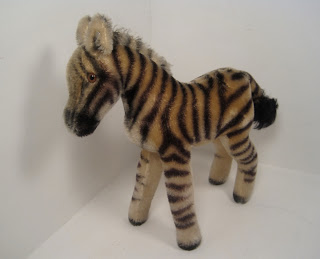Steiffgal couldn't help but want to outfox this mystery presented to her from a reader about a vintage family treasure. Marcia from Virginia asks about a present a daughter received from a high school boyfriend many years ago. She writes...
"Dear Steiffgal,
I have a 20 inch, seated upright fox. His head turns, but he is not jointed other than that. His mouth is open and the two fangs are a bit broken. The Steiff button is in his ear but there is only a tiny piece of the yellow tag.
He is red fox color -- reddish brown gold-- on the back, and his front or belly is white; ears are black on the back and white inside and standing up. Whiskers are stiff and it looks like two have been cut short. His tail is about 18 inches; it helps to balance him in the upright position. The front paws come out at an angle and then point toward the ground.
My questions are, how old is his and what is his story?
I appreciate your help!
Like the body position of this great find, Steiffgal is "begging" to provide Marcia with everything she needs to know about her most interesting piece. This item is called Rotfuchs or Red Fox. He is 22 inches or 56 cm tall and in a standing/"begging" pose... meaning that he is up on his hind legs and has the appearance of welcoming any table scraps someone would send his way! He has a very life-life face, including brown and black glass eyes, an open pink felt lined mouth (which when new had a long red felt tongue and pointy teeth), thick clear monofilament whiskers, and a black hand embroidered nose. Also of note is his large and bushy tail, which in this case helps him to balance in his standing/begging position. This fantastic fox was made from 1962 through 1971 and was a United States exclusive for the upscale toy store chain FAO Schwarz.
According to the 1962 FAO Schwarz Centennial Celebration catalog, this exact item is described as... "Red Fox, import. This life-sized fox by Steiff - 23" tall to the tips of his ears, has a bushy, long (16") tail. In realistically colored rust and white plush, with authentic markings, red tongue, and white teeth. Shipping weight 4 lbs., $28.50." There are two things about this description to note from the collector's perspective. First, even though FAO Schwarz describes him as "lifesized", he is not technically categorized as a studio animal by Steiff. Second, it is interesting to calculate that $28.50 in 1962 dollars translates roughly into a little over $200 in 2011 dollars. So he was quite the investment, even back then!
FAO Schwarz and Steiff have had a very special relationship since the turn of last century which remains in place to this day. Steiff made its first appearance in 1906 in the United States through the FAO Schwarz's store in New York. Starting right after WWll in the 1950s, Steiff began creating store exclusives for its long-time American retail partner; in essence, these could be considered early "limited editions" produced by the company. These early treasures included a series of dressed mice, families of dogs and cats in pillow-lined baskets, unique studio (life-sized) pieces including a beagle and a collie, and even "Royal Dally" - a Dalmatian dressed to the nines in a jeweled crown and fancy cape - among many other items. Even though these early post war exclusives are all no more than 60 years old (which is still considered relatively new in the Steiff collector's world), they are all on the "bucket lists" of most Steiff collectors and generate much excitement when they come on the secondary market.
Like this fantastic fox, Steiffgal hopes that this overview has left you bright eyed and bushy tailed about FAO Schwarz exclusives.
Have a question about one of your Steiff treasures? Let's talk! Click here to learn more.
























